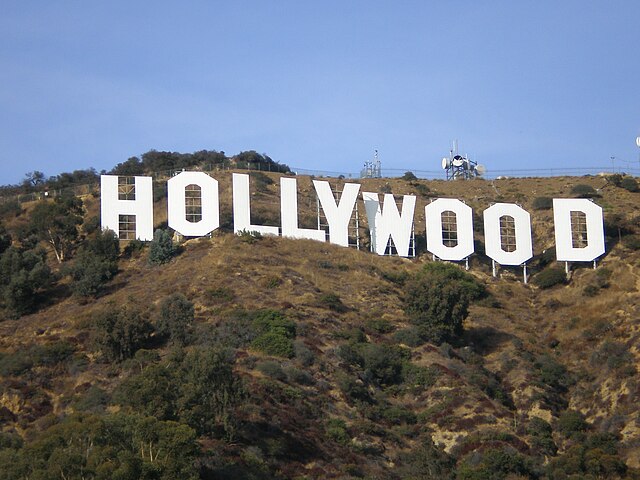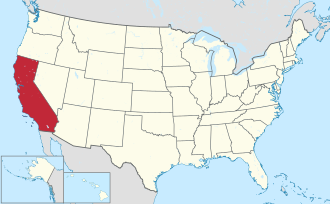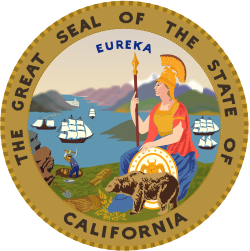California
state of the United States of America From Wikipedia, the free encyclopedia
Remove ads
California, officially the State of California, is a state in the western part of the United States, along the Pacific Ocean.
It is the third biggest US state by area (after Alaska and Texas) with 163,696 square mi (423,970 km2). It has more people than any other state with over 39 million people as of 2020. It also has more people than Canada. Its largest cities are Los Angeles, San Diego, San Jose, and San Francisco. The capital is Sacramento. The states around its borders are Arizona to the southeast, Oregon to the north, Nevada to the east, and the Mexican state of Baja California to the south.
Remove ads
Geography
California, which has a North/South orientation, has a wide range of climates.
The geography of California varies depending on the region. Southwestern California has small mountain ranges and the cities of San Diego and Los Angeles. Southeastern California has the Mojave Desert and Death Valley, the lowest place in the United States. The eastern part of the state has the highest point in the United States outside of Alaska: Mount Whitney, in the Sierra Nevada mountain range.[9]
The cities of Sacramento, Bakersfield, and Fresno are in the Central Valley. The valley has the Sierra Nevada to the east and the Pacific Coast Ranges to the west. It is California's single most productive agricultural region and one of the most productive in the world. It produces more than half the fruit, vegetables, and nuts grown in the United States.[10] More than seven million acres (28,000 km2) of the valley are irrigated by an extensive system of reservoirs and canals.[11]
The west-central part of the state has some small mountains and the cities of San Francisco, San Jose, and Oakland. Northern California has the Cascade Range, the Klamath Mountains, and the Modoc Plateau.[12] Far northern California does not have many people, but the San Francisco region and the Sacramento region are often thought of as part of northern California.
Climate
Flora and fauna
California is home to many animals such as racoons, the California condor, and the mountain lion. California’s official flower is the California poppy. California was once home to the Grizzly bear and the jaguar. California poppy is the official flower of California.
Remove ads
Culture


The state is a leader in three businesses: farming, movie-making, and high technology, mostly software and websites. Aerospace used to be a large industry there, but it has been downsized in the last 20 years.
California is very diverse. Today it has high numbers of Hispanic and Latino Americans, Arab Americans, and Armenian Americans.
California is known for its Mexican food, Mexican culture, Cholo subculture and having the largest Mexican and Chicano population outside Mexico.[13]
There are many earthquakes in California. They happen when two tectonic plates (parts of the Earth's crust) shift underground. Californians need to be prepared for earthquakes and often store extra food, water, flashlights, and first aid supplies in case of such an emergency.
California has more people than any other state in the United States. If California was a separate country, it would have the sixth largest economy in the world. California is probably the state with the most ethnic groups. It also has many different geographic features – mountains, deserts, and coasts. It is often called The Golden State. The state flower is the golden poppy. The post office uses "CA" as a shorthand for California, and the Associated Press uses "Calif." or "Cali."
California has a large population of Mexican Americans. Mexican Americans have influenced Californian cuisine and Californian culture. California also has a large Filipino, Vietnamese, Korean, Japanese, Indian, and Chinese population. There aren't as many white people in the state but there are still many Russian, Spaniard, German, English, Scottish, Portuguese, Italian, Dutch, Irish, and French people in the state. Other ethnic groups in California are Serbians, Persians, Bulgarians, Navajos, Cherokees, Nicaraguans, Alaskans, and Romani people.
California is popular among celebrities. Celebrities such as Kim Kardashian, Dwayne Johnson, Kylie Jenner, and Jennifer Aniston are from California.
California English is a dialect of the English language spoken within California. California is the home to a highly diverse populace, and this is reflected in many other languages, especially Spanish. As is the case of English is spoken in any state, not all features of California English is used by all speakers in the state, and not all features are restricted in use only to the state. However, there are some linguistic features which can be identified as either originally or predominantly Californian.
California is famous for In-N-Out Burger, which is the regional chain of fast food restaurants and founded in 1948 by Harry and Esther Snyder.[14]
Protestantism and Catholicism are the most practiced religions in California. A smaller population are Jews, Muslims, Hindus, and Buddhists.
Marijuana became legal in 2016.
Californian cuisine is influenced by Spanish cuisine, Mexican cuisine, and Asian cuisine. Mexican food is very popular in California.
California is popular for its tourism. Hollywood and Disneyland are popular tourist destinations in California. Most tourists in Los Angeles come from Mexico, China, Canada, Australia, the United Kingdom, Japan, Vietnam, South Korea, France, Germany, Scandinavia, Middle East, and most recently, India, Spain, Italy, and Southeast Asia.
Remove ads
Politics
In 2019, Gavin Newsom became the governor of California. Before him, the governor was Jerry Brown.
On November 4, 1992, Dianne Feinstein became one of California's United States senators. On January 3, 2017, Kamala Harris became the other one. In the 2020 presidential election, Kamala Harris was elected as the first woman and person of color to be Vice President of the United States.
In January 2021, Alex Padilla became the next U.S. Senator, replacing Harris, and became the first Hispanic U.S. Senator from the state.
California was more conservative during the 1960s and 1980s when its former governor, Ronald Reagan, ran for president as a Republican. Today, California is more liberal and less conservative.
History
The people in Coastal California were Native Americans. The original Californians were a diverse population, separated by language into as many as 135 distinct dialects. Tribes included the Karok, Maidu, Cahuilleno, Mojave, Yokuts, Pomo, Paiute, and Modoc. In the past, the area that was called "California" was not just today's California. This area covered the Mexican lands south of it, as well as Nevada, Utah, and parts of Arizona and Wyoming. The Spanish called the part of the land that later became part of the United States Alta California (Upper California) when it was split from what became Baja California (Lower California). In these early times, the borders of the Sea of Cortez and the Pacific coast were not well known, so the old maps wrongly showed California to be an island. The name comes from Las sergas de Espladián (Adventures of Spladian), a 16th-century book by Garci Rodríguez de Montalvo, where there is an island paradise called California.
The first European who visited parts of the coast, Juan Rodriguez Cabrillo, came from Portugal in 1542. The first European who saw the entire coast was Sir Francis Drake, in 1579, and he decided that the British owned it. But starting in the late 1700s, Spanish religious leaders of the Roman Catholic Church ("missionaries") got large gifts of land in the area north of Baja California, from the Spanish king and queen. These religious people set up small towns and villages, the famous California Missions. When Mexico was no longer controlled by Spain, the Mexican government took over the villages, and they soon became empty.

In 1846, as the Mexican-American War was starting, some Americans in California hoped to create a California Republic. These men flew a "Bear flag" that had a golden bear with a star on it. This Republic ended suddenly, however, when Commodore John D. Sloat of the United States Navy sailed into San Francisco Bay. He said that California was now part of the United States. After the war with Mexico ended, California was split between the two countries. The Mexican portion became the Mexican states of Baja California Norte (north) and Baja California Sur (south). ("Baja" means "lower" in Spanish.) The western part of the part given to the United States became today's state of California.
In 1848, there were about 4,000 Spanish-speaking people in today's California on the American side. (Today the state has a total of nearly 40,000,000 people.) In 1849, gold was suddenly found and the number of people went up very fast as the Gold Rush took hold. Slavery also spread there as people hoping to find gold brought African slaves and either forced them to work in gold mines or hired them out for other work.[15] In 1850, California became a state in the Union (the United States).
During the American Civil War (1861-1865), many people in California, especially in the southern part of California, thought the South was right and slavery should be protected. Some people in Southern California even wanted Southern California to leave the rest of the state and join the Confederate States of America. However, this did not happen. California joined the war to and helped the North (the Union) and sent many troops east to fight the Confederacy.[16]
At first, travel between the far west and the east coast of the United States was dangerous and took a lot of time. Going by land was very difficult, because there were no roads and no trains, and many Native Americans were attacking American people heading West in wagons. The only other way was to travel by boat around the Cape Horn, at the southern end of South America. This took months, since the trip was thousands of miles long and the Panama Canal had not yet been built either. But in 1869, the connection got better quickly, because the first railroad across the continent was finished. Meanwhile, more people in California were learning that the land there was very good to grow fruit and other crops. Oranges were grown in many parts of California. This was the beginning of the huge farming business that California has today.
Remove ads
Economy
The economy of the State of California is the largest in the United States. It has a gross state product (GSP) of US$3.0 trillion as of 2020.[17] It has many sectors. The most dominant are finance, business services, government and manufacturing. If California were a sovereign nation, according to 2023 statistics, it would rank as the world's fifth largest economy, lying between Japan and India.[18] Over 10% of the Fortune 1000 companies were based in California in 2018.[19]
Among the largest economies, it is ranked as number four in the world, according to media (2025).[20]
Remove ads
Present day
In 1900, there were only a million people in California and 105,000 in Los Angeles. Today, California has more people than any other U.S. state. Starting in 1965, the variety of people became much greater as many different people from around the world came to the United States and often decided to live in California. Technology is very advanced and many new cultural trends begin there. Engineering and computers play a big part in the state's life. For over a hundred years, film has been one of the most important businesses in California. By the 1950s, television had also become an important business in California. Many Latinos especially Mexicans and Salvadorans live in the state.
In the twenty-first century, droughts and frequent wildfires attributed to climate change have occurred in the state.[21][22] From 2011 to 2017, a persistent drought was the worst in its recorded history.[23] The 2018 wildfire season was the state's deadliest and most destructive, most notably Camp Fire.[24]
California has a growing Hispanic and Asian population. White people are the second largest ethnic group in California. Hispanics surpassed the white population in the 2010s.
Although air pollution problems have been reduced, health problems associated with pollution have continued. The brown haze that is known as "smog" has been substantially abated thanks to federal and state restrictions on automobile exhaust.[25][26]
In 2021, the number of Hispanic and Latino residents in California had surpassed the number of white residents, with about 15.75 million Hispanics compared to 13.4 million white residents.
Remove ads
References
Other websites
Wikiwand - on
Seamless Wikipedia browsing. On steroids.
Remove ads






